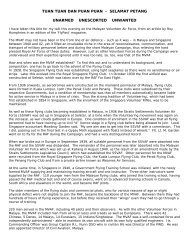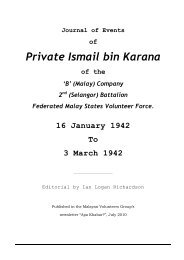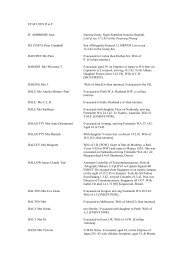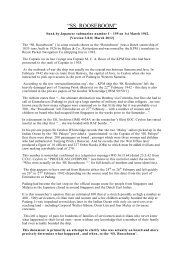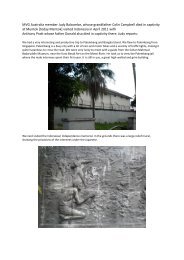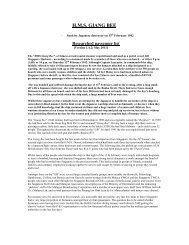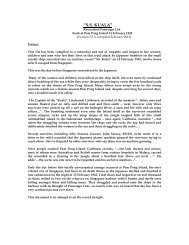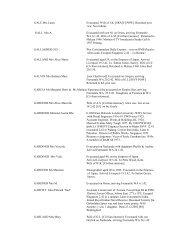SINGAPORE AND THE THAI RAILWAY EXPERIENCES OF ...
SINGAPORE AND THE THAI RAILWAY EXPERIENCES OF ...
SINGAPORE AND THE THAI RAILWAY EXPERIENCES OF ...
You also want an ePaper? Increase the reach of your titles
YUMPU automatically turns print PDFs into web optimized ePapers that Google loves.
__________________________________________<br />
Now we go on to May 1943<br />
* We were at Wampo, which lies on the Minam (?Menam) Kah Wei river about 50 miles<br />
North West of Kanchanaburi in Thailand. We had arrived on Oct. 27th '42 and the 1,700 in<br />
camp had completed the track of railway for 7 kilometres North and South, including 2 very<br />
long stretches around precipitous cliffs 300 feet high in a sheer drop to the river. I had<br />
worked on both track and bridges and kept well except for a slight attack of malaria in April.<br />
The Nips provided quinine and<br />
18.<br />
Page 5<br />
and I very soon recovered. We had a difficult march up to Tarso from Ban Phong, a distance<br />
of 86 kilometres, which took us 5 days. We carried most of our kit, what we left behind was<br />
largely stolen and looted by the POWs that came afterwards - in particular the Argylls, the 9th<br />
Coast Regt. and some Australians. This stealing of our kit placed men in a very difficult<br />
position and it is impossible to forego the contention that the lack of their blankets and those<br />
few tins of Red Cross food we brought from Singapore contributed largely to the heavy death<br />
rate in Thailand. The thieves stole the clothes, mosquito nets, etc., and sold them for high<br />
prices to the Thais. Prices at first were about $10 or rather 10 ticals for a pair of trousers,<br />
about 20 ticals for a blanket. As large quantities<br />
Page 6<br />
of clothes were offered for sale the prices of course dropped. The most fortunate of the<br />
POWs to go to Thailand were the Australians. The Nips had told them that as Australia was<br />
taken they would soon be sent back to their homes and it was not till April '43 that they were<br />
brought to Thailand, although 4,000 had gone in May '42 to Burma. Whilst in Singapore they<br />
had the full benefit of the Red Cross supplies from South Africa including, of course, our<br />
share, which was not sent to Thailand. When they arrived in April '43 they were very fit, and<br />
found the British in poor condition as they had already been in the jungle for 6 months. Our<br />
first 6 months at Wampo from Oct. 27th till April '43 were spent in good weather. After the<br />
wet monsoon ended in early Nov., the weather became dry and for six months there was<br />
barely a wet day.<br />
Page 7<br />
The nights were cold and the mornings clear and invigorating. In better times with good food<br />
and plenty of clothing and adequate medical supplies the place would have been positively a<br />
health resort. The camp was on the banks of the river and we soon cleared the site of trees<br />
and small bushes and erected attap and bamboo huts. Attap is a thatch of palm leaves, which<br />
was brought up the river in barges. We slept on platforms of crushed bamboo. Mosquitoes<br />
were not common and we slept well. For the first 3 weeks we had very poor food. There was<br />
a small supply of poor quality rice, a little salt and a few snake gourds ( a type of vegetable<br />
marrow). Breakfast was 1 pint of boiled rice pap and plain tea (1 pint). Dinner was 1 pint<br />
boiled rice and marrow stew with salt about 1/2 a pint very thin with 3 or 4 small cubes of<br />
marrow and plain tea. Supper was the same as



